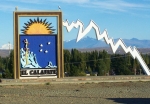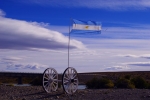Information about El Calafate
El Calafate is a city on the southern shore of Lake Argentino, in the region of Patagonia, in the province of Santa Cruz, Argentina, about 80 km from the glacier Perito Moreno.
It is the head of the department Lago Argentino. At 2012 El Calafate is one of the three major cities of the province of Santa Cruz ranking third in population, behind the cities of Rio Gallegos and Caleta Olivia.
It is located about 320 km northwest of the provincial capital, Rio Gallegos. It owes its reputation for being the gateway to Glacier National Park, which has attractions like the glacier Perito Moreno, the Upsala glacier, and Fitz Roy), among others, all typical of eastern Icefield South Patagonia and Torres del Paine National Park in Chile.
Before the arrival of the white man, the area of ??El Calafate already received from the aonikenk the name Kehek Aike or (better pronounced: Kegesh Aike), meaning the first word -kehek- "leave", "deposit" and the second word -aike- "human whereabouts", that is to say: Whereabouts that is a repository of artifacts and human goods.
As a permanent locality El Calafate arises in the first decades of the 20th century. Originally, it was no more than a point of provisioning of the wool transports, made in catango (cart), from the ranches of the region, which explains the original name of Kehek Aike.
It was officially founded in 1927 by the Argentine government, in order to consolidate the settlement of the region.
However, it would be the National Parks Administration responsible for consolidating the town. In 1943 the construction works of the intendency of the Los Glaciares National Park (completed in 1946) begin. At that time the town had only about a hundred permanent inhabitants. For many years, National Parks was the most important institution in the town, bringing electricity, inaugurating the first cinema, opening roads, building bridges, managing the first hostelry of the town, among other infrastructures.




